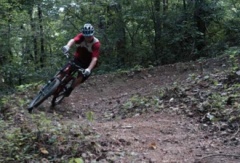
of trails, including some single-track.
(Photos: USFS)
The U.S. Forest Service has begun the official, 30-day public comment period on the ‘Preliminary Assessment’ of the Timberline Mountain Bike Trails and Skills Park Project. The project would include watershed restoration projects and the development of 17 miles of lift-assisted downhill mountain bike trails and a skills park in the southern portion of the existing Timberline Ski Area on Mt. Hood (about 55 miles east of downtown Portland).
As we shared last April, designers behind the Timberline project envision it as a major riding destination on par with world-famous Whistler Mountain Bike Park in Canada.
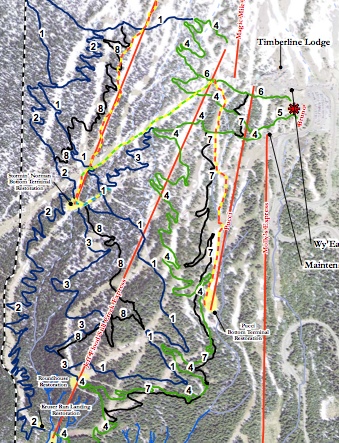
– Download full size (PDF) –
Not surprisingly, there is already a debate taking place about the proposal. Back in July, we strong opinions on both sides of the issue following the initial project comment period.
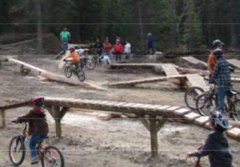
(Photos: USFS)
One of the loudest voices against the idea is Portland resident Dennis Chaney. Chaney is a board member of Friends of Mt. Hood and he’s concerned that the bike trails would pose a risk to the environment. In a February 2nd Sandy Post op-ed he wrote, “The ski lift base that would be used in this proposal sits in the watershed for two critical habitat streams.” Chaney also refers to downhill mountain biking as “…arguably the most damaging recreational activity we can bring to an alpine environment.”
It’s worth noting that the proposal includes significant soil and watershed restoration projects. In their recently released Preliminary Assessment (download it here), the Forest Service determined the restoration projects that come with the mountain bike park development would actually leave the mountain in better shape than it is now. Here’s an excerpt from their “Soils Report”:
“… the restoration actions have been modeled and evaluated to reduce sediment risk by a two to one ratio, a substantial improvement over the current condition. In addition, the restoration actions are scheduled to occur either slightly before or concurrently with the proposed trail construction, thereby offsetting potential impacts in both time and space. The restoration projects are in fact, so essentially important to offsetting the impacts of the proposed trails that they themselves are included in the proposed action. Proven effective in other locations on the mountain, it is with the highest confidence that they will be fully effective as designed.”
Northwest Trial Alliance President Tom Archer says his organization supports the proposal. Reached via telephone today, he told us, “There’s a need for it and we feel it’s better to have these types of activities in a controlled environment where they can be managed.” As for environmental concerns, Archer said, “We think the design has been done in a way to minimize potential impact to environmental resources.”
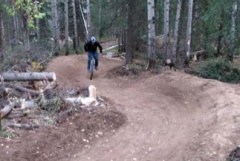
Archer was part of a large group of stakeholders that took a walking tour of the proposed trails back in September. He noted that the park’s designers, Gravity Logic, have made environmental concerns a top priority. “They made a lot of adjustments [to trail routing] to avoid particularly sensitive areas. There won’t be any in-water crossings, it will all be bridged.”
The comment period last summer was to demonstrate the “need” for this project and the USFS received enough supportive comments to move forward. Now they are looking for comments on their preliminary assessment in order to complete the Environmental Assessment and “help guide the final decision.”
If the project moves forward, trail construction would begin this summer. Read the preliminary assessment documents here and direct your comments to Christy Covington and sent to comments-pacificnorthwest-mthood-zigzag@fs.fed.us.
There will be an open house on the project on March 17th, 4:00 pm at the Zig Zag Ranger District Headquarters (70220 E Highway 26).


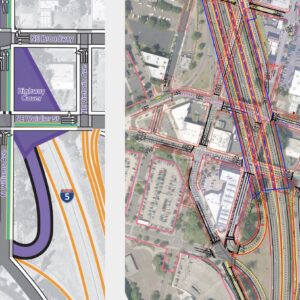



Thanks for reading.
BikePortland has served this community with independent community journalism since 2005. We rely on subscriptions from readers like you to survive. Your financial support is vital in keeping this valuable resource alive and well.
Please subscribe today to strengthen and expand our work.
Why does Oregon hate mountain biking so much? Almost every other mountain state has embraced the lift-served ski/mountain bike model, with very little complaint of damage to the environment. Just seems like an ill-informed empty argument that somehow still holds weight in this region.
It would be great if they put a decent climbing trail to access the downhill sections so those of use who like to ride up as well could enjoy the trails.
“arguably the most damaging recreational activity we can bring to an alpine environment.”
I guess we need to (again) show this fellow the numerous scientific studies that have shown Mtn. biking (if build correctly) as no more impact than hiking to the trail.
You don’t need to hate mountain biking to hate this project. It is an expansion of private, for-profit control of public land. People who want to ride a bike on land that they own shouldn’t have to pay a corporation for the privilege. Meanwhile, the forest service is doing the same thing to the campgrounds: handing management to a concessionaire so that the public will have to pay more to access something we already own. If the Forest Service were serious about bike access, they would convert some of their 4000 miles of mostly crumbling, useless roads to bike trails.
The forest service is also demonstrating their contempt for public process by holding a final comment period in winter when to public cannot access the site and assess the design. This may follow the letter of the law, but it demonstrates a clear desire to fast-track whatever timberline’s managers want.
I’m glad that this project is exposing the cracks in an ideology that sees anything involving a bike as benign and virtuous. It time to apply some critical thinking and realize that bikes can also be just another accessory in the service of consumerism and exploitation.
Option #1: Let a private company with both resources and incentives build and maintain awesome trails and then sell access to their already in place chair lifts so that mountain bikers can ride; bringing jobs, money and fun to our area.
Option #2: Try really hard to get the forest service to build trails with public money, because its public land.
Sounds like you’re advocating for option #2…and yet calling others ideological.
If I have to choose between paying for great mountain bike riding or staying home for free, I choose riding.
Yes. Other places (winter Park for one) run their mountain bike trails on Forrest service land. you know what that means? Exactly what others have said. You can ride the trails all you want, only you’ll have to pay Timberline for using their lift. So as long as USFS sticks to the precedent they have set at other resorts, those trails will be open to as well (for free) as long as you wan to pedal back up the mountain.
Exactly.
There are lots of places on Mt Hood that I’d like to ride my bike, that I used to be able to until just a few years ago and now I can’t.
There is also nothing in the proposal that says you can’t ride your bike here if you don’t want to pay. You just won’t be able to ride the lift up to do so.
I, for one support this project. It will cut down on illegal trail poachin, trail conflicts and will contribute to the economy through jobs and tourism.
I’m glad there is a private company involved because they are willing to spend some money fighting the nutjobs from the sierra club and these other “environmental” groups who are trying to prevent people from using trails. They want many of the hiking/biking trails that exist today to revert to “wilderness like states”. I used to support the sierra club but you can’t trust them. These same people who are fighting the development were there telling us that it was no big deal when they grabbed all the trails for wilderness, because we would be able to use other trails. Some of the trails that are in this development already exist and have been used for mountain biking for years like the glade trail. People who oppose this are right on par with the forest park people who want the woods to be only for their desired use.
I was thinking this sounds exactly like Forest Park all over again.
“…fighting the nutjobs from the sierra club and these other “environmental” groups who are trying to prevent people from using trails. …” Bjorn
If you think it’s going to be to your benefit, go ahead and enjoy yourself, mouthing off with that kind empty-headed rudeness. People other than yourself with honorable values that are widely regarded, that you seem to enjoy ridiculing with spite, are reading this website. If your remarks are the kind that you wish to present as an example of who off-road bikers are, have at it.
In the last series of bikeportland threads on the Timberline off-road biking park, I generally expressed comments favoring the idea of the park because the activity was contained to a relatively small area. In doing so, I also pointed to some examples in this country and other parts of the world where off-road biking allowed in natural areas has resulted in some very dramatic consequences. Are the consequences ‘negative’, or are they ‘positive’? Good question.
The pictures Maus has chosen to illustrate this story with; the solo rider on banked, radiused turns, the ramps and platforms stretching across a bald patch of ground, provide a fairly clear example of why non-off-road bike outdoor enthusiasts might have misgivings about encouraging in natural areas, the type of off-road biking planned for this park.
People should be able to have fun though. Personally, what I’m seeing in those pictures is not beautiful, or evocative of the types of natural areas I’ve experienced around Mt. Hood. If off-road bikers are happy to spend their time in the kind of setting shown in those pictures, in a contained park, let their wish in that regard come true.
FYI, banked corners like that are designed to prevent erosion and trail widening. The skills area, while bald, is small and designed to shepherd new riders into the sport in a safe and contained manner.
Gabe…thanks for the FYI. I knew what the purpose of the banked corners is. And that is absolutely the kind of engineering that needs to be done to support the kind of off-road bike activity intended for this park. The answers given as to why the kind of track they’re part of needs to be on the timbered slopes of Mt Hood is what’s leaving many people unconvinced they should be there.
I hear you on that argument. In many areas I’d agree with you wholeheartedly, but interspersing these types of trails in an already heavy-use area with clearcut slopes and infrastructure is perfect. There are many thousands of unspoiled acres of forest on Mt Hood. Timberline does not fall in that category.
As part of the proposal, the Glade trail is set to be decommissioned after the Timberline-Town trail is completed and routed through the park. Not sure if the new T-T trail will accomodate DH bikes or not.
It is just like Forest Park with the politcal BS. Friends of Mt Hood, Forest Park etc. tenticles of hippyness reach far. The fact is this park will be amazing and create a ton of tourism to the area. The area is very small in comparison to the Mt Hood National forest area that is closed to bikes. Maybe we could advocate for calling the trails “bike boulevards” instead and have painted arrows, with signs and lighted crossings at the streams to appease the screwballs that are bashing the idea as it is.
Public lands should be open to all appropriate uses, even the ones that are not PC approved. Designating certain areas for more intense use will likely reduce that same use in other areas and help protect those areas. Projects like this will manage the trails in a way that hardens them to the expected use. This is mandatory for the project to succeed since no-one will pay to use crappy and washed out traIls. These types of projects exist in almost every state. Oregon fancies itself as forward thinking on many issues but is woefully behind on this one. Just because this kind of biking does not replace a car trip doesn’t make it invalid. Try and be tolerant of other peoples interests as well. It’s all about biking after all!
Well, over the years I have spent something like 5k on whistler trips, so a bike park a little closer to home would be amazing. I seriously doubt timberline will ever get to that size, but honestly even if they only got halfway I would impressed.
I heard a rumor that Bachelor was looking at a bike park as well, don’t know if that is true or not though.
It costs a lot of money to build and maintain a trail system like this. It costs even more money to maintain lifts. If that means it costs me money to use those lifts so I can access a bunch of killer trails all day, I’ve got no beef with that. And yes, I would probably drive all the way over from Pendleton to ride there, so yes, it would be good for tourism too.
Yay! +1 for the bike park! Yay!
@wsbob, calling Timberline Ski Area a Natural Area is like calling the Columbia Slough a Wild and Scenic River… Or Pam A’s breasts real… There’s nothing natural about it. It’s a developed recreation area. Besides the lifts and chairs, there’s shacks, sheds, rutted roads, heavy equipment, tanks, old ski race stuff, junk… All sorts of stuff that comes with running the place all over.
Matt, to some extent, you’re correct, that the clear-cuts undertaken by Timberline and other ski/resort areas to create ski runs, have something to be desired in terms of meeting the definition of a ‘natural area’. Looking at a wide view of the mountain with its ski runs chopped into the slopes makes it unavoidably clear that these kinds of developments are a dramatic, ugly intrusion.
So, these developments are a compromise. Clear-cut the slopes for ski runs and you get to downhill ski. Clear-cutting the slopes doesn’t do much for the mountain’s beauty, but, again…now people get to ski, and since lots of people like to ski…ski resorts and skiing get quite a lot of common support from the general public. To a point. Which explains in part why Mt Hood didn’t get another ski resort on the mountain’s north side.
It remains to be seen whether off-road biking will ever get anything close to that kind of support in Oregon. It’s a standing of long record that Oregonians tend not to do stuff just because other states and countries have done it or are doing it.
@wsbob, I’m not the one who burned these bridges.
We should not continue to work with these people because they will continue to stab us in the back. The sierra club says they are pro bike but every time they get the chance they advocate closing trails that are currently open to mountain biking or oppose creating new trails. This should be something that they support, concentrating use in an already heavily managed place where things like properly banked corners and bridges over streams will prevent erosion and damage to more sensitive areas. Instead they continue to blindly oppose mountain biking in practice while praising it in theory.
wsbob: The bike park experience will not be about scenery. There are a lot of scenic trails in the area. Both the park and the XC trails provide a different experience.
“wsbob: The bike park experience will not be about scenery. …” JM
No kidding? On this point, I think you’ve probably got many people agreeing with you.
That off-road biking of this type is not about scenery or an interest in experiencing the natural wonders inherent in the slopes of Mt Hood and other beautiful natural areas offer, is exactly one of the key reasons the sport comes up against the opposition it does.
For a long time now, it’s been apparent that the type of off-road biking that this park is about, has little interest in the intrinsically beautiful character of the areas where enthusiasts seek access for the sport.
That is completely untrue. Way to spin his words. Anyone who tries to spin that myth really needs to step back and examine their lives. The outdoor experience is completely subjective. Every individual that enters the outdoors has the freedom to interact in whatever means they choose and what they take from that experience is completely up to them. Just because some cyclists don’t stop to smell every flower, investigate every track, examine every blaze mark on a tree, doesn’t mean they’re not gaining something from the being in the outdoors. The outdoors isn’t all panoramic sunsets and triple rainbows. It’s being outside, away from the daily grind, relieving tension in an out of ordinary environment, escaping.
The misguided, single faceted, selfish, ignorant approach to people and the outdoors has to stop. There is no one way to enjoy the outdoors and just because some people don’t agree with one activity doesn’t mean it’s wrong or shouldn’t take place.
If you really want to split hairs, has anyone seen the trees with in the ski area boundary? They’re overgrown, dense, infested with disease and parasites, suffering from decades of fire suppression and lack of thinning (which is both good and bad). Point being, since the activity will be primarily taking place within the treeline, there really isn’t a whole lot to look at besides deadfall, snags, scraggly little firs and pines and lichen. If one wants a view, they’ll get it from the chairlift, just like the skiers (and no one is telling them to take their activity elsewhere).
If anyone has any doubt about how popular this system will be, should just go down the road and check out the parking area at Skibowl. Or go even further down to the new Sandy Ridge system. There is huge demand for more trails on Mt. Hood.
I’ll be first in line.
I’m a hiker, as well as bike commute during the spring and summer in Portland. I’m torn by this issue for a couple of reasons.
One, it does interest me that creating trails like this taking people off the trails I hike on would be a great advantage, provided that that actually happens. As much as people like the idea of sharing trails, hiking and mountain biking don’t mix as well as you might think. In mixed use situations on narrow trails, I get quite concerned for myself, my wife and kids, especially when some mountain biker comes around the corner too fast.
So I like the idea of this trail system for biking in ski areas.
My only concern is anecdotal. In doing lots of hiking around Mt Hood, including going completely around the Timberline trail a couple of times, the areas where I see the MOST wildlife, especially larger animals, is in the ski areas, not in the designated wilderness. This might seem contrary to conventional wisdom, but some of the best meadows and short grass and flower foraging occurs in the strips where ski runs are created and maintained.
Perhaps some attention needs to be given to how much of the ski areas are affected by this, and what the impact will be to local wildlife.
Otherwise I support the idea.
This issue has been addressed, it’s in the EIS.
Matt, March 8th, 2011 12:35 …take another look at the pictures Maus used to illustrate his story. The off-road bike track shown in those pictures has turned the area into a mud hole. If that’s the kind of place off-road bikers enjoy spending their time, good for them, but there isn’t a very strong argument that they need a fragile alpine environment to create such an activity area in.
In your comment,you also note about the environment: “…deadfall, snags, scraggly little firs and pines and lichen. …”. You do realize, don’t you? That this is an alpine environment? Being a higher elevation, and colder, with soil that’s rockier than down in the valley, plants grow much more slowly. It’s a big part of the reason plants up there look so gnarly. It’s a tough environment for plants to survive in, which is another reason why the prospect of off-road bikes in that environment isn’t received with the broad enthusiasm off-road bikers hope for.
“Matt, March 8th, 2011 12:35 …take another look at the pictures Maus used to illustrate his story. The off-road bike track shown in those pictures has turned the area into a mud hole. ”
What are you talking about? Where? Where are the images from, what’s their location? No one has mentioned any mud, mud holes, recreating in mud or anyone enjoying it, let alone turning your fragile, rocky (last I heard it was “moondust”, which is it?) alpine environment into a mudhole.
Quit playing the Devils Advocate. Your arguments are weak and have no basis in fact.
As far as the tree comment goes, I was simply identifying their condition based on the foresters report from the preliminary environmental assessment. There was nothing about the soil condition or climate in the report that suggested any impact on the condition of the forest.
Matt…re-read my comment. I specifically mentioned the pictures illustrating Maus’s story. You copied and pasted the section of of my comment where I said so. Just scroll up and you’ll see them. I have no idea where the pics were taken (call or write the U.S. Forest Service to find out…they’re credited for the pics), but Maus is using them to offer readers an example of what could possibly be typical of the new off-road bike park that may be built on Timberline.
If you want to make a case for off-road biking in natural areas, this is the kind of thing you’re going to have to figure a way to provide an effective response to.
You said the area has become a mud hole. Where is the mud hole? If you’re strictly referring to the images as they appear and not the exact locale where the picture was taken, then I don’t see any mud. It looks like dirt. It looks like bare dirt. Bare dirt can be graded to maximize drainage. If in case the dirt becomes mud, the area can effectively be closed because it’s in a privately run, controlled environment. Chances are the open area will be seeded with native grasses and/or gravel and the high traffic areas leading into and out of the structures will be armored with pavers to maintain the integrity of the soils (as noted in the project scope).
But, as you also mentioned in your previous post, Timberline has “soil that’s rockier than down in the valley”, so drainage really shouldn’t be an issue if thats the case…
Mud? Dirt? You can call it whatever you want. What I’m saying, is that the image presented in the pictures illustrating this story, is of large expanses of bare dirt devoid of anything growing on it.
One picture shows a trail width that’s easily twice as wide as would be required for a walking trail, or even a single track bike trail. The bottom picture, showing track with berms, is easily 3-4 times as wide as the aforementioned types of trails. The picture with the ramps and elevated wood tracks like about a 100′ square area, or more. All dirt. How well do you think that’s going to drain when it gets wet?
For off-road bikers, that’s probably alright though, because from what I’ve been able to tell, off-road bikers don’t much mind messin’ in the mud and getting dirty. Cyclo cross riders too. In fact, they seem like being in the mud.
Read JEFF KOHNSTAMM’s Op Ed in the Sandy Post if you’re really concerned about the integrity of Timberline and their actions. He is putting his, his families, and his corporations reputation on the line with that piece. If he doesn’t believe that the park is detrimental to the mountain and/or the Lodge experience then that’s good enough for me. He’s not some foreign corporate conglomerate that is out to rape our environment and leave us with an ecological disaster. He believes its good for the economy, the community, and most importantly the environment. And the research is being done to back that.
KOHNSTAMM is a businessman. He’s running a ski resort that could really use bike business to cover for when the snow isn’t there for skiing. Of course he’s going to support the construction of this bike park. KOHNSTAMM’s dad ( Grandad? Uncle?), virtually saved Timberline Lodge from turning to kindling, so he’s a good guy.
I believe that family does have substantial regard for the environment their business is situated in. Still, that business is part of a big industry, which means money, and thus power to potentially be exerted by those that willing to spend the money for activities offered. When enough money is waved in the face of business owners, the temptation to adjust their principles can be great. I think so far though, Timberline has been pursuing this thing properly.
But anyway, it’s not me that’s trying to spike this project. I’m just pointing out some of the simple realities associated with certain types of off-road biking in certain types of areas. Whether people support or oppose uses of the environment such as this one, awareness of their impact is important.
To clear up some misconceptions, the proposed park will have controlled access via two entrance trails and a ticket will be necessary to enter.
i am a portland resident and frequent the whistler mountain bike park a handful of times each summer. this is based solely on my subjective experience but the bears or deer never seemed too bummed of the downhill bikes. one bear actually told me that they only qualm they had were the locks on the trash cans in the village. i hear it devastates the available food supply for the black bear population.
if the trails that are being utilized are going to be newly cut, will that have an impact on hikers? i usually hike on existing trails and not through densely wooded slivers of trees between ski runs.
between the year-round lodging and summer skiing on the palmer glacier that brings in visitors from around the world and also creates a two hour long lift line to get a run in, i don’t think that rlk and co are hurting too bad during the off season.
maybe the kohnstamm family truly wants to expand the recreational experience for those who visit the mountain as well as boost the economy for the lodge and the entire mt. hood corridor. pretty brave to embark on such a project during such hard economic times if you ask me.
i don’t think this project would have been planned as well as the proposal suggests if they were in it solely for the money.
just random thoughts…